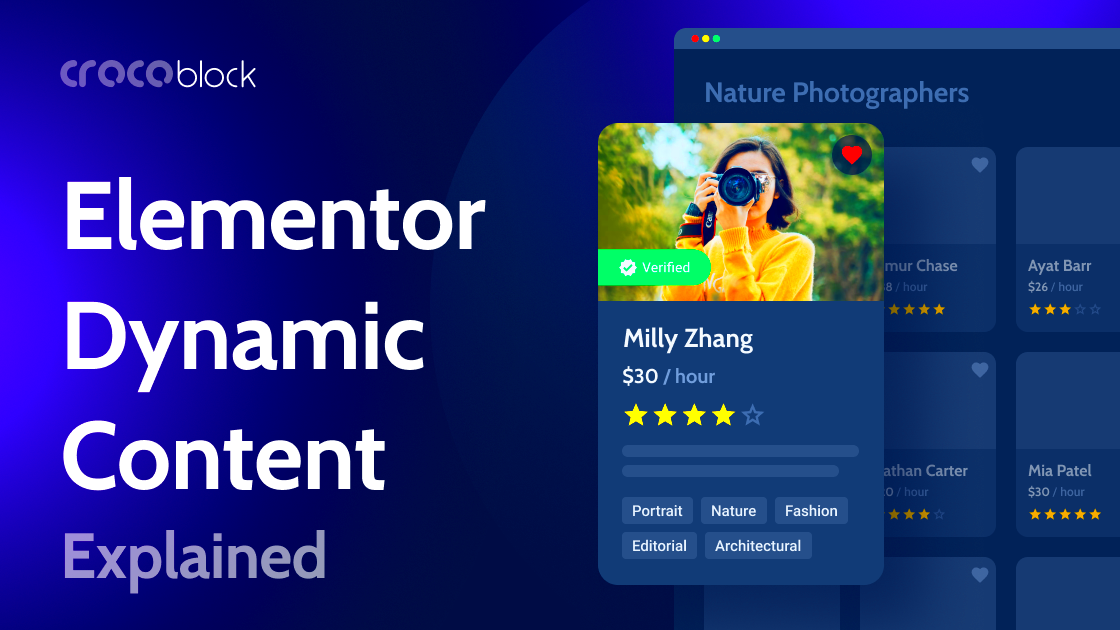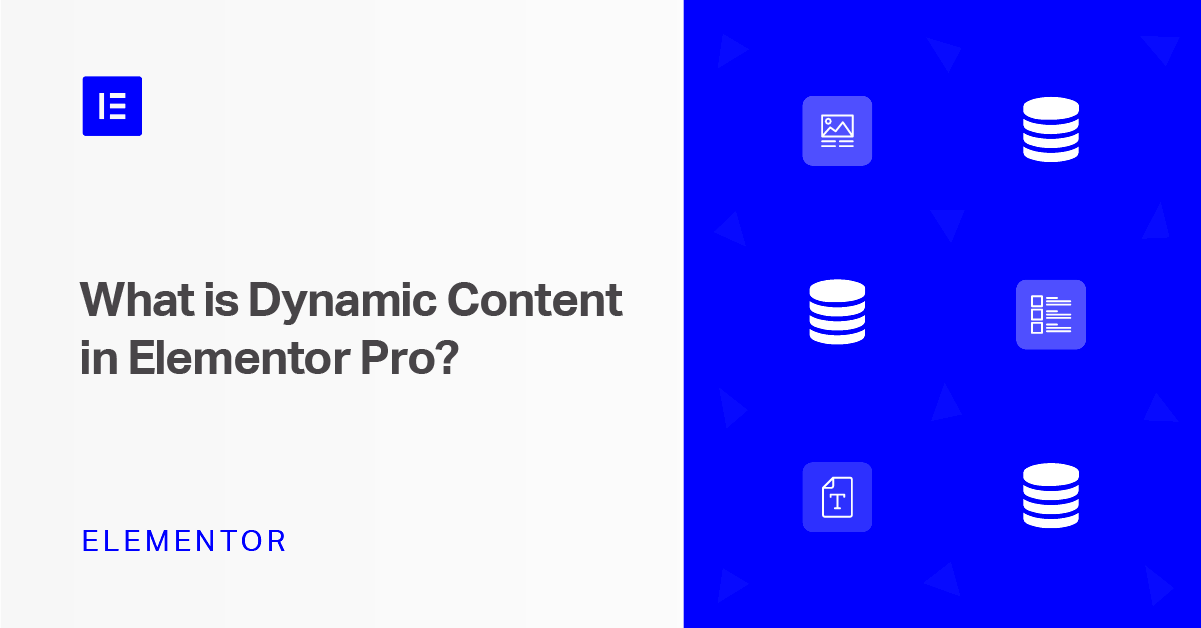In the world of web design, static content is becoming a thing of the past. Consumers want websites that feel personalized, engaging, and relevant to their interests. This is where dynamic content comes into play. Dynamic content refers to web content that changes based on user behavior, preferences, and interactions. It creates a more immersive experience for visitors and can significantly enhance engagement and conversion rates.
Imagine visiting a site that changes its offerings based on your past clicks, location, or even the time of day. That’s dynamic content at work! In this post, we will explore how dynamic content enhances user experience and how it can be effectively implemented using Elementor, one of the most popular page-building plugins for WordPress.
What is Elementor?

Elementor is an incredibly versatile page builder for WordPress that simplifies the web design process. With its intuitive drag-and-drop interface, users can create stunning websites without needing to know a scrap of code. Whether you’re a seasoned developer or a complete beginner, Elementor offers the tools and flexibility you need to design engaging and functional web pages.
Some key features of Elementor include:
- Live Editing: See the changes as you make them, allowing for a seamless design experience.
- Pre-made Templates: Start your designs quickly with professionally designed templates that you can customize.
- Responsive Design Controls: Ensure your site looks great on all devices, from desktops to smartphones.
- Widgets and Blocks: Utilize a wide variety of widgets to add functionality, like galleries, sliders, and forms.
In short, Elementor empowers users to create beautiful and effective websites with ease. With its incorporation of dynamic content capabilities, Elementor is a powerful tool for developers looking to create engaging, personalized experiences for website visitors. So, let’s dive deeper into how dynamic content works with
Understanding Dynamic Content

Dynamic content is one of those fancy terms that can sound complex, but once you get to know it, you realize it’s all about making your website smarter and more engaging. Imagine a webpage that changes automatically based on its visitors or the information in your database. That’s precisely what dynamic content does! Instead of serving the same fixed information to everyone, it tailors the experience based on various data sources.
In Elementor, dynamic content pulls information from your WordPress database and displays it on your pages. It’s perfect for websites that require frequent updates, such as blogs, portfolios, or online shops. For instance, if you have a blog with several posts, you can use dynamic content to showcase the latest articles, automatically updating the list without you needing to do a thing!
Here are a few key points to understand about dynamic content:
- Data-Driven: Content changes based on user interaction or pre-set criteria.
- Versatile: Links directly to various WordPress elements, such as custom fields, taxonomy, and user data.
- User-Centric: Enhances user experience by showing relevant information, making visitors feel more engaged.
This capability is especially valuable for businesses looking to provide personalized experiences. It helps to maintain a dynamic environment where content feels alive rather than static—essential for keeping your audience interested!
Benefits of Using Dynamic Content in Elementor
Utilizing dynamic content in Elementor offers a treasure trove of benefits that can significantly enhance your website’s appeal and functionality. So, why should you consider using it on your site? Let’s unravel those advantages:
- Efficiency and Time-Saving: Imagine updating your services or blog posts across multiple pages without having to manually change each one. Dynamic content automatically pulls data from your site, saving you hours of work—perfect for busy entrepreneurs!
- Consistency Across the Site: Dynamic content ensures that all areas of your website have the same up-to-date information. Consistency makes your site look professional and reliable, which builds trust with your visitors.
- Personalization: The more personalized your content, the more your visitors will connect with your site. Using dynamic content allows you to show users information that resonates with them, like previous purchases or their location.
- Improved SEO: Dynamic content can enhance your SEO strategies. Search engines appreciate fresh and relevant content, so updating your site automatically with dynamic data can boost your rankings.
- Enhanced User Engagement: When users see content that directly speaks to their interests or needs, they are more likely to engage with it. This engagement can lead to longer visit durations and lower bounce rates!
In a nutshell, embracing dynamic content in Elementor can take your website from ordinary to extraordinary. With the many benefits it offers, you can create a more engaging, efficient, and user-friendly online presence, ensuring your site evolves in line with your audience’s needs and expectations.
How to Set Up Dynamic Content in Elementor
Setting up dynamic content in Elementor can seem daunting at first, but it’s actually quite straightforward. Let’s walk through the process step-by-step, so you can start utilizing this powerful feature to enrich your website without pulling your hair out!
- Install Elementor and Elementor Pro: First things first, ensure you have both Elementor and the Pro version installed and activated on your WordPress site. The Pro version unlocks dynamic content capabilities.
- Create or Edit a Template: Go to your WordPress dashboard, click on “Templates,” and either create a new one or edit an existing template. This could be for a single post, page, or even a custom post type.
- Add Dynamic Fields: Once inside the Elementor editor, drag over a widget that supports dynamic content—like the Heading, Image, or Text Editor. You’ll notice a small “Dynamic Tags” icon in the settings panel.
- Select Dynamic Tags: Click on the “Dynamic Tags” icon, and a list will pop up showing all available dynamic content options. Options include Post Title, Featured Image, Custom Fields, and much more. Pick the one that suits your needs.
- Configure Settings: After selecting a dynamic tag, you may need to tweak some settings. For instance, if you chose “Post Title,” you can add styling to customize how it appears on your page.
- Preview and Save: Make sure to preview your changes to see how the dynamic content looks. If it meets your expectations, hit the “Publish” or “Update” button!
And there you have it! You’ve set up dynamic content in Elementor. It’s a game-changer for creating a personalized and engaging user experience.
Common Use Cases for Dynamic Content
Dynamic content isn’t just some fancy feature; it can genuinely transform how users interact with your site! Understanding its common use cases can inspire you to harness its full potential. Let’s dive into some popular applications that can breathe new life into your Elementor website!
| Use Case | Description |
|---|---|
| Blog Posts | Automatically display titles, authors, publication dates, and categories in a consistent format across your blog. |
| Custom Post Types | Utilize dynamic fields to show specific details related to any custom post types, such as portfolios, testimonials, or products. |
| User Profiles | Enhance member or user profile pages by displaying relevant information like usernames, profile images, or account details dynamically. |
| E-commerce Products | For online shops, you can showcase product names, prices, descriptions, and reviews dynamically, streamlining the shopping experience. |
| Event Listings | Display essential event information, such as titles, dates, and locations, that updates automatically for ongoing or upcoming events. |
As you can see, the possibilities are endless! Incorporating dynamic content not only saves time but also ensures your site remains relevant and engaging. So go ahead, explore these use cases, and let your creativity flow!
Integrating Dynamic Content with Custom Fields
Integrating dynamic content with custom fields in Elementor is a game-changer for anyone looking to create a truly customized website. Custom fields allow you to add unique data to specific posts or pages, acting like an extra layer of information that’s not typically available in standard WordPress settings.
To start, custom fields can include anything from text, images, or even complex data types. This means you can tailor the user experience based on the specific information you want to display. For instance, if you’re running a real estate website, you might want to show custom fields for properties, such as price, location, and unique features.
Here’s how you can integrate dynamic content with custom fields:
- Step 1: Install a custom fields plugin like Advanced Custom Fields (ACF) or Pods.
- Step 2: Create custom fields relevant to your content types.
- Step 3: Fill in those fields when adding or editing posts/pages.
- Step 4: Use Elementor’s Dynamic Tags feature to pull in those custom field values dynamically.
This integration massively enhances your site’s flexibility by allowing you to display tailored content based on the data you consider important. Not only does it create a more cohesive experience for the visitor, but it also demonstrates a level of professionalism and thoughtfulness that can set your site apart from the competition.
Best Practices for Using Dynamic Content
When it comes to using dynamic content in Elementor, following some best practices can make all the difference in how your site performs and how users interact with it. Here are a few guidelines to help you get the most out of dynamic content:
- 1. Keep Data Organized: Organize your custom fields logically. Use naming conventions that make it easy to identify what each custom field represents.
- 2. Leverage Repeater Fields: If you have multiple items to display (like gallery images, product features, or team member details), use repeater fields to keep your layout neat and manageable.
- 3. Test Responsiveness: Always test how your dynamic content appears on various devices. Elementor allows you to preview different screen sizes, making it easy to adjust if something looks odd on mobile or tablet.
Here’s a quick tip:
- Consider implementing fallback content. In case a custom field is empty, set up an alternative message or default content so users don’t see blank spaces.
Ultimately, the goal is to provide users with a fluid and enjoyable experience. By using dynamic content wisely, you’ll not only enhance user engagement but also encourage visitors to explore more of what your site has to offer. Remember, the cleaner and more organized your dynamic content is, the easier it will be for users to navigate your site!
Frequently Asked Questions about Dynamic Content
When diving into dynamic content for Elementor, it’s natural to have a barrage of questions. Dynamic content can transform the way your website interacts with users, but it can also lead to some confusion. Let’s tackle some common questions you might have!
1. What is dynamic content?
Dynamic content refers to content that changes based on user interaction or pre-defined conditions. Instead of being static, such content can tailor itself to the viewer, making for a more personalized and engaging experience. In Elementor, this means you can pull in data from various sources, like posts, custom fields, or user profiles.
2. How can I use dynamic content with Elementor?
Using dynamic content in Elementor is quite straightforward. Here’s a quick rundown:
- Select the widget you want to edit.
- In the content settings, look for the “Dynamic” icon (usually represented as a database or a lightning bolt).
- Choose what type of dynamic content you wish to display, such as post info, author name, or custom fields.
3. Do I need coding skills to implement dynamic content?
Not at all! Elementor provides a user-friendly interface, so even those without coding knowledge can set up dynamic content. However, having some understanding of custom fields or post types can be beneficial.
4. Can I use dynamic content with custom post types?
Absolutely! Elementor supports custom post types, allowing you to display dynamic content from various data sources seamlessly. This can greatly enhance the functionality of your website.
5. Is dynamic content good for SEO?
Yes, using dynamic content wisely can improve your SEO. By keeping content fresh and relevant for users, search engines favor sites that offer engaging and regularly updated information.
With these FAQs in mind, you should have a clearer understanding of what dynamic content is and how you can leverage it to create compelling websites with Elementor!
Conclusion
In summary, dynamic content for Elementor opens up a world of possibilities for web design and user engagement. By harnessing the power of dynamic data, you can create websites that feel more personal and relevant to your visitors. Whether you’re a novice or a seasoned developer, Elementor’s easy-to-use interface makes it accessible for everyone to implement dynamic content seamlessly.
Here’s a quick recap of the key points we discussed:
- Enhanced User Experience: Dynamic content allows websites to provide tailored experiences based on user interactions, giving every visitor unique content suited to their needs.
- Flexibility: Whether it’s pulling in blog posts, showcasing testimonials, or displaying custom fields, dynamic content brings versatility to your site.
- SEO Benefits: By keeping your content current and relevant, dynamic content can improve your search engine ranking.
So, as you venture into the world of dynamic content with Elementor, remember to experiment, test, and see what resonates with your audience. Happy designing!



